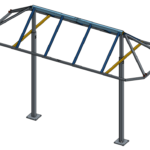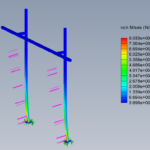SUNDOWN ADVENTURELAND FRAMES
JC Design were asked to provide a design service for a contract down south. The requirement was for steel frames to be embedded into poly foam structures.
The frames were designed and then stress tested to ensure that they can support the foam and have an adequate factor of safety. KD Decoratives were especially keen to validate the designs to the customer.


A hut frame was designed to support thatching as well as the poly foam covering.


Each frame had a different shape, the bamboo frame above had a cantilever force due to the centre of gravity. This was taken into account when the FEA was employed.

The Temple arch was the most simple and did not required as much design time.
The Importance of Stress Analysis in Validating Structures for Public Safety
Stress analysis plays a crucial role in ensuring the safety, reliability, and longevity of structures used in public settings. Whether applied to bridges, buildings, transportation systems, or public venues, it helps engineers predict how materials and designs will respond to real-world forces.
1. Ensuring Structural Integrity
- Stress analysis identifies weak points in a structure before construction or installation, preventing failures that could lead to injury or loss of life.
- It helps engineers optimise material use while maintaining strength, ensuring structures can withstand expected loads without unnecessary weight or cost.
2. Compliance with Safety Standard
- Stress analysis allows engineers to verify that designs comply with legal and regulatory requirements, reducing the risk of liability and ensuring public confidence in the structure’s safety.
3. Preventing Catastrophic Failures
- By simulating worst-case scenarios such as high winds, earthquakes, extreme temperatures, or heavy traffic loads, stress analysis ensures that a structure can endure both expected and unexpected stresses.
- Early detection of potential fatigue or stress fractures allows for preventive maintenance, extending the lifespan of infrastructure.
4. Cost Efficiency & Sustainability
- Stress analysis reduces material waste by optimizing designs, ensuring that only necessary reinforcements are added.
- Preventing failures and minimising maintenance costs contributes to long-term economic sustainability for companies.
Conclusion
Stress analysis is a critical tool in public infrastructure design and maintenance. By ensuring safety, compliance, and efficiency, it protects lives, reduces costs, and reinforces public trust in the built environment. Without it, structural failures could lead to devastating consequences, making its role in engineering indispensable.
https://sundownadventureland.co.uk/rides-and-attractions/ostrich-safari-ride/